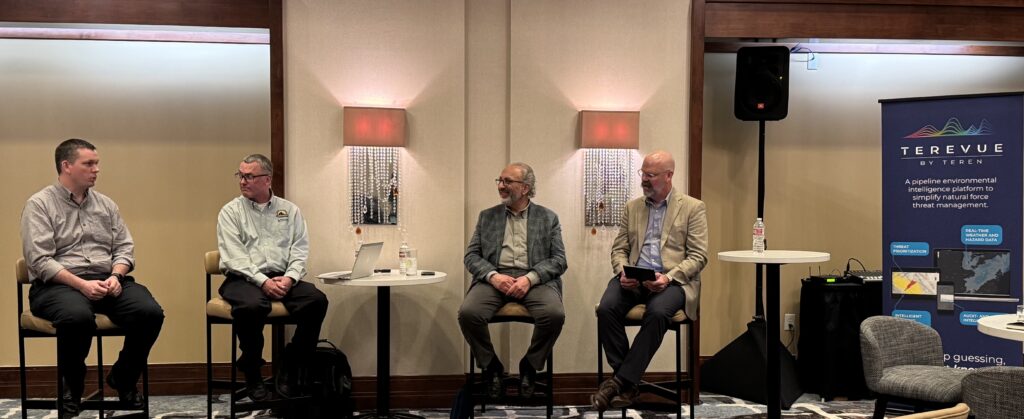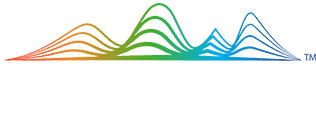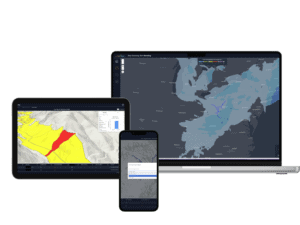On March 3, 2025, Teren hosted an expert panel in Houston, bringing together leading pipeline operators and industry experts to discuss the evolving threats posed by weather and external forces. The panel featured a geohazard program representative from an industry partner, Jared Kowis (Enbridge), Moness Rizkalla (Visitless Integrity Assessment Ltd) and was moderated by Brian Ellis (pipelinelogic). The conversation highlighted key challenges, emerging best practices, and the role of advanced geospatial data in mitigating risk.

Key Threats Facing Pipeline Operators
The panelists emphasized that hydrotechnical and geotechnical hazards remain among the most pressing threats to pipeline integrity. River scour, waterway crossings, and landslides were identified as universal concerns across the industry. While water crossings are known variables that operators can monitor and mitigate, landslides present a greater challenge due to their unpredictable nature.
Jared Kowis, Geohazard Program Supervisor at Enbridge, explained that while earth observations from above may look adequate, “you may not be able to see the underlying threats.” That’s because landslides are active instances that interact with many other factors (like strain accumulation, terrain) that ultimately lead to a pipeline failure. “Very few ruptures are due to a single hazard. A lot of them are corrosion, but corrosion on a slope. It’s often a combination of threats rather than just one cause,” added Moness Rizkalla, Principal Consultant at Visitless Integrity Assessment Limited.
Finding the Right Data and Technology in Risk Management
Data-driven decision-making was a recurring theme throughout the discussion. Operators shared how they leverage tools like LiDAR, Inertial Measurement Units (IMU), photogrammetry, and probabilistic modeling to assess risk. Real-time monitoring solutions, such as slope stability gauges and hyperspectral AI, were highlighted as game-changing innovations.
“we’ve tried things like InSAR, optic multi-spectral satellite imagery, and real-time monitoring to improve our geotechnical monitoring. But ultimately the question is, ‘What does this buy me in terms of value?’”
In discussing the integration of new data sources, Kowis pointed out, “we’ve tried things like InSAR, optic multi-spectral satellite imagery, and real-time monitoring to improve our geotechnical monitoring. But ultimately the question is, ‘What does this buy me in terms of value?’” Meaning: there are endless possibilities of data to be collected, but if it’s not catered to your specific problem, it’s data deadweight.
That said, panelists agreed that no single technology offers a complete solution—integrating multiple data sources is essential for a comprehensive risk management strategy.
The geohazard program representative described their multi-prong approach: “We combined Teren’s framework that looks at susceptibility to these types of threats, along with bend strain and severity assessments to build a prioritized risk approach. From there, we identify the most at-risk areas, conduct LiDAR and bend strain assessments that help identify areas needing deeper investigation.”
Balancing Regulatory Compliance with Practical Risk Mitigation
The discussion also touched on regulatory developments and industry best practices. The introduction of API 1133 and API 1187 was recognized as a positive step in guiding operators on managing hydrotechnical and geotechnical threats. However, panelists debated the challenges of balancing regulatory compliance with practical risk mitigation.
Kowis emphasized, “The requirement for inspections after integrity-related events is a step in the right direction, but defining what constitutes an ‘integrity event’ is still a gray area. Every operator has different risk tolerances, and there’s no one-size-fits-all answer.”
Panelists underscored that moving beyond compliance and adopting a proactive approach to pipeline safety will ultimately be more effective in reducing failures.
Lessons from Innovative Global and Cross-Industry Practices
Operators drew insights from international pipeline management practices and other industries such as aviation and infrastructure. Case studies from South America illustrated how extreme weather events are driving innovative risk management solutions, such as rain gauge networks at high-risk locations.
Rizkalla shared an example from Colombia: “These guys are hit so hard with extreme precipitation events that they’ve installed rain gauges at their 250 highest-risk locations. That level of monitoring is unheard of in North America, but it’s a sign of how critical proactive data collection is becoming.”
Additionally, the operators noted how they learn from approaches across other industries, like mining or transportation, to inform their geohazard mitigation and models for pipeline infrastructure resilience.
The Future of Pipeline Integrity Management is About Making Data Actionable
Looking ahead, panelists acknowledged the increasing impact of climate change on external force threats. While predictive analytics and AI-driven monitoring are promising, they are still in the early stages of adoption.
“The challenge isn’t just having the data—it’s making it actionable.”
The geohazard program representative remarked, “We’re building a digital viewer to integrate susceptibility, LiDAR, photogrammetry, bend strain, and other datasets so we can better communicate risk internally. The challenge isn’t just having the data—it’s making it actionable.”
Panelists called for greater industry collaboration to refine best practices and enhance the integration of geospatial intelligence into integrity management programs.
The discussion underscored that while pipeline operators face evolving threats, advancements in technology and data analytics provide unprecedented opportunities to enhance safety and resilience. By leveraging the latest innovations and fostering industry-wide knowledge sharing, operators can stay ahead of emerging risks and protect critical infrastructure for the future.


How can Teren help you?
We'd love to hear from you.
- Ready to dive deeper? -
Knowledge Hub
White Papers
Webinars